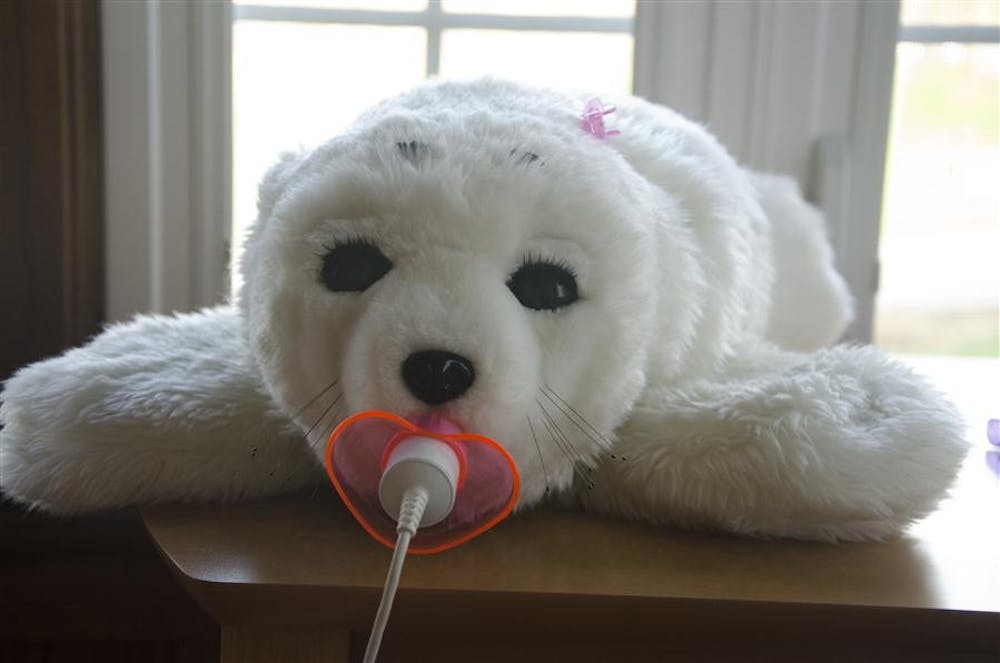Two-year-old Anastasia tapped the stuffed baby seal doll on the head and jerked away, giggling. Then the doll started blinking.
Students in the School of Informatics and Computing sponsored an open house at the University’s official robot research center, R-House, on Wednesday. They wanted to honor the nation’s second annual National Robotics Week.
The R-House opened last year. Since then students have used it to show off research projects produced in different classes. Wednesday’s open house featured projects with titles such as “lost and found robot,” “Dewey break management robot,” “home security robot” and “Paro therapy robot.”
Kris Hauser, an associate professor of computer science, said National Robotics Week and projects such as the R-House can help educate the public and inspire new generations of robotic technology experts.
“We designed the event so that it is family-friendly and an opportunity to see what’s going on in research and education on robotics and other emerging technologies at IU,” Hauser said in a press release.
Senior Greg Starr has been working on a robot to prevent people from losing their keys and other small objects.
“We looked at it and asked, ‘How can we solve that problem?’” Starr said. “We considered using a central location.”
Starr said he and his team worked on designs that would assist memory. They came up with a robot that would light up and make sounds when a person walked into his or her home, reminding him or her to hang his or her keys on their hooks. The project is still under construction.
Graduate student Sarah Reeder collaborated with several others to create Dewey, a robot designed to alert computer users to take breaks.
“It was really difficult to get working,” Reeder said.
Dewey was built to sense temperature and motion when someone sat in front of a computer. Thirty minutes later, Dewey would light up and start shaking to let the user know to take a break.
Reeder said her group used focus groups to test the robot and gain valuable feedback. She said only one member of the group noticed the physical alert. Users preferred the physical Dewey that sat on a desk to an Internet Dewey that popped up on-screen.
“Even though the project technically failed, we learned a lot,” Reeder said.
Senior Shi Hui Lim and junior Josh Cravens were two of the collaborators who wanted to investigate whether different designs for robots would help people feel more or less safe in their homes.
Their results were varied. Lim said people who did not already have home security systems were most comfortable with robots designed to appear humanoid, while those who already owned home security systems preferred a small, box-like robot.
“People that don’t have a home security system are less likely to want to adopt a robot,” Cravens said.
Anastasia patted the robot, Paro, as her mother asked her what Paro was doing. The robot began blinking its huge black eyes, so Anastasia started blinking dramatically at her mother in demonstration.
Anastasia’s father, Thomas Sugimoto, said he and his family first started going to robot open houses last year when his wife, an IU faculty member, heard about them from fellow staff. He said his daughter quickly fell in love with Paro.
Paro was developed for therapy to replace real animals. Many hospitals have been leery about allowing animal-assisted therapy and activity, despite its positive effects, because of the possibility of allergy, infection and bites, according to a pamphlet from the National Institute of Advanced Industrial Science and Technology.
Developers chose to make Paro a baby harp seal rather than a cat or dog so people could accept the robot without preconceptions. The robot sports soft, white artificial fur and responds to touch and motion by moving its head, fins and tail, blinking and making cooing noises.
It was these reactions that caused young Anastasia to spend the majority of her time with Paro despite the other technological wonders throughout the house.
“She loves this robot,” Sugimoto said. “So we take her whenever Paro is out on display.”
Informatics robots protect, cuddle, serve

Get stories like this in your inbox
Subscribe





